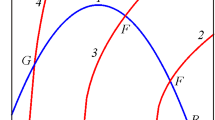Abstract
In this approach, the plastic part of the deformation field, traditionally described by regular mappings, is interpreted as localized yielding along flow surfaces, with a kinematics analogous to that of crack formation. The resulting deformation is structured, being composed of a bulk and a surface part, respectively due to the elastic distortion of massive material portions and to localized yielding. There is an energetic competition between these two contributions in the energy functional, whose minimization is sought under irreversibility conditions for the inelastic phenomena. Numerical experiments are performed with a regularized variational approach. Paradigmatic examples show that plastic strain concentrates in coarse bands, but the bands may coalesce to form a plastic region, depending upon the shape and size of the body, the presence of pre-existing defects (voids, holes, notches) and the values of the governing parameters.

















Similar content being viewed by others
Notes
Recall that the model of [9] is symmetric in tension-compression, so that it does not rule out overlapping of crack lips.
References
Ambrosio, L., Tortorelli, V.M.: Approximation of functional depending on jumps by elliptic functionals via Γ-convergence. Commun. Pure Appl. Math. XLIII, 999–1036 (1990)
Ambrosio, L., Fusco, N., Pallara, D.: Functions of Bounded Variation and Free Discontinuity Problems. Oxford Mathematical Monographs. Clarendon/Oxford University Press, Oxford (2000)
Ambrosio, L., Lemenant, A., Royer-Carfagni, G.: A variational model for plastic slip and its regularization via Γ-convergence. J. Elast. 110, 201–235 (2013)
Bangerth, W., Hartmann, R., Kanschat, G.: deal.II differential equations analysis library, technical reference. http://www.dealii.org
Barenblatt, G.I.: The mathematical theory of equilibrium cracks in brittle fracture. Adv. Appl. Mech. 7, 55–129 (1962)
Bažant, Z., Planas, S.T.: Fracture and size-effect in concrete and other Quasi-Brittle materials. CRC Press, New York (1998)
Benzarti, K., Freddi, F., Frémond, M.: A damage model to predict the durability of bonded assemblies. Part I: Debonding behavior of FRP strengthened concrete structures. Constr. Build. Mater. 25(2), 547–555 (2011)
Bigoni, D., Dal Corso, F.: The unrestrainable growth of a shear band in a prestressed material. Proc. R. Soc. A, Math. Phys. Eng. Sci. 464, 2365–2390 (2008)
Bourdin, B., Francfort, G.A., Marigo, J.J.: Numerical experiments in revisited brittle fracture. J. Mech. Phys. Solids 48, 797–826 (2000)
Del Piero, G.: A variational approach to fracture and other inelastic phenomena. J. Elast. 112, 3–77 (2013)
Dugdale, D.S.: Yielding of steel sheets containing slits. J. Mech. Phys. Solids 8, 100–104 (1960)
Fleck, N.A., Muller, G.M., Ashby, M.F., Hutchinson, J.W.: Strain gradient plasticity: theory and experiment. Acta Metall. Mater. 42, 475–487 (1994)
Focardi, M.: On the variational approximation of free-discontinuity problems in the vectorial case. Math. Models Methods Appl. Sci. 11, 663–684 (2001)
Francfort, G.A., Marigo, J.J.: Revisiting Brittle fracture as an energy minimization problem. J. Mech. Phys. Solids 46, 1319–1342 (1998)
Franco, A., Royer-Carfagni, G.: Energetic balance in the debonding of a reinforcing stringer: effect of the substrate elasticity. Int. J. Solids Struct. 50, 1954–1965 (2013)
Freddi, F., Frémond, M.: Damage in domains and interfaces: a coupled predictive theory. J. Mech. Mater. Struct. 1(7), 1205–1233 (2006)
Freddi, F., Royer-Carfagni, G.: Regularized variational theories of fracture: a unified approach. J. Mech. Phys. Solids 58, 1154–1174 (2010)
Freddi, F., Royer-Carfagni, G.: Variational fracture mechanics to model compressive splitting of masonry-like materials. Ann. Solid Struct. Mech. 2, 57–67 (2011)
Frémond, M.: Non-smooth Thermomechanics. Springer, Heidelberg (2001)
Froli, M., Royer-Carfagni, G.: On discontinuous deformation of tensile steel bars: experimental results. J. Eng. Mech. 125, 1243–1250 (1999)
Froli, M., Royer-Carfagni, G.: A mechanical model for the elastic-plastic behavior of metallic bars. Int. J. Solids Struct. 37, 3901–3918 (2000)
Körber, F., Siebel, E.: Zur theorie der bildsamen formänderung. Naturwissenschaften 16, 408–412 (1928)
Lancioni, G., Royer-Carfagni, G.: The variational approach to fracture mechanics. A practical applicaton to the French Panthéon in Paris. J. Elast. 95, 1–30 (2009)
Nadai, A.: Theory of Flow and Fracture of Solids. McGraw-Hill, New York (1950)
Nakanishi, F.: On yield point of mild steel. Rep. Aeronaut. Res. Inst. 6, 83–140 (1931)
Ord, A., Vardoulakis, I., Kajewski, R.: Shear band formation in Gosford Sandstone. Int. J. Rock Mech. Min. Sci. 28, 397–409 (1991)
Palmer, A.C., Rice, J.R.: The growth of slip surfaces in the progressive failure of over-consolidated clay. Proc. R. Soc. Lond. Ser. A, Math. Phys. Sci. 332, 527–548 (1973)
Pham, K., Marigo, J.J., Maurini, C.: The issues of the uniqueness and the stability of the homogeneous response in uniaxial tests with gradient damage models. J. Mech. Phys. Solids 59, 1163–1190 (2011)
Rice, J.: The localization of plastic deformation. In: Koiter, W.T. (ed.) Proceedings of the 14th International Congress on Theoretical and Applied Mechanics, Vol. I, pp. 207–220. North-Holland, Amsterdam (1976)
Rittel, D., Wang, Z.G., Merzer, M.: Adiabatic shear failure and dynamic stored energy of cold work. Phys. Rev. Lett. 96, 075502 (2006)
Wolf, H., König, D., Triantafyllidis, T.: Experimental investigation of shear band patterns in granular material. J. Struct. Geol. 25, 1229–1240 (2003)
Acknowledgements
The authors gratefully acknowledge the Research Fund for Coal and Steel for support under grant RFSR-CT-2012-00026 (“S+G” research project).
Author information
Authors and Affiliations
Corresponding author
Rights and permissions
About this article
Cite this article
Freddi, F., Royer-Carfagni, G. Plastic Flow as an Energy Minimization Problem. Numerical Experiments. J Elast 116, 53–74 (2014). https://doi.org/10.1007/s10659-013-9457-y
Received:
Published:
Issue Date:
DOI: https://doi.org/10.1007/s10659-013-9457-y




